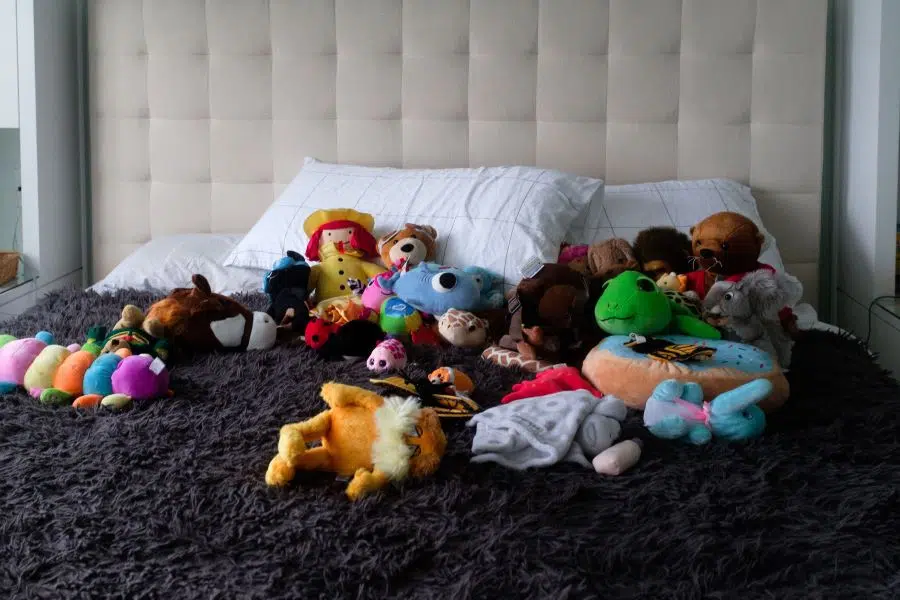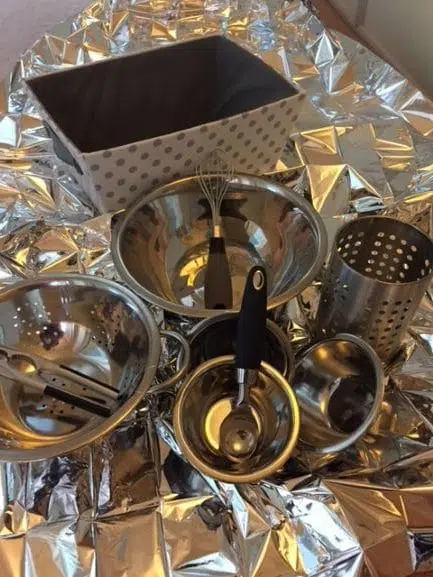My two-year-old nephew visited me recently. Within seconds he’d managed to tip the cat’s water and food bowl up, and while I dealt with that, he tipped all the shoes off the shoe rack and emptied my recycled food waste container on the floor for good measure!
It felt like I was under siege!
But what’s the answer to this?
The best way to help your child move through this emptying and tipping phase is to provide even more opportunities to practice tipping and emptying.
When a toddler tips or empties objects on the floor, they are beginning to learn about object permanence. This means that they are beginning to understand that just because they can’t see a toy anymore, it does still exist in the world.
The more opportunities you provide to tip and empty, the quicker they will learn, and the faster they will move through this phase.
In this post, I’ll explain exactly why your toddler is emptying all drawers in sight, and exactly what to do about it.

Toddlers Emptying Drawers – Why It Happens
When the dreaded “terrible two” stage strikes, it can mean your toddler not only throwing tantrums but also leaving a trail of mess as they tip and empty everything in sight. Sometimes this phase can last for a while and it’s definitely one of the more demanding stages of child development for both parents and childcare practitioners.
I can’t turn my back for a second! You can hear the parents of toddlers cry. Despite child locks on kitchen cupboards and drawers, it’s amazing what a toddler can find to tip up and empty once they enter this phase.
So what is actually happening here?
It’s actually a very normal, and yes, I agree, a very frustrating part of normal child development.
Your child is actually exploring and experimenting with all kinds of new concepts as they progress through this stage. One of those concepts is gravity.
Sometimes these phases are referred to as schemas.
A schema is a repeated pattern of behavior. Children are continually creating a model of reality in their minds. They test reality based on this model, and these repeated behaviors are called ‘schemas’. (Source) It’s perfectly normal, and almost all children demonstrate schemas at some point.
Children Are Tipping And Emptying To Learn
It may feel as though your toddler is making a massive mess everywhere, just to annoy you, but they are actually learning and processing new concepts.
They have an inbuilt need to physically tip and empty containers to understand what the consequences of that are.
For some children, they may need to repeat this lots of times before they can move on to the next stage of their development.
Things You May Notice During This Stage (And Why)
-You might have noticed your toddler dropping their spoon from their high chair, not just once, but over and over again. Every time you pass the spoon back, they are beginning to understand that the spoon hasn’t disappeared by magic. Passing it back to them is helping them to understand this.
-When they tip toys out of a container, they may be exploring the same thing.
-When a toddler tips up, empty, or drops their toys intentionally, they are also learning that their actions cause an effect. They’re beginning to understand that when they use a tipping motion, the toys or objects end up on the floor.
As adults, we already know that if we tip up a drawer of socks, the socks will litter the floor. A toddler doesn’t necessarily know this yet and they need to see it happen a few times in practice before they understand and their brain can process this information.
How To Help Your Child Through This Phase
To help your child move through this phase, you can provide lots of empty containers, baskets, or boxes with objects that they can safely tip-up.
You can help them as they play, by using the words:
- Full
- Empty
- All gone
- Start again
They may also be exploring what a container looks like, once it is empty, as toddlers are also developing their understanding of spatial awareness.
Once empty, you may see your toddler try to get inside the container, sit down in it, put their arms or legs into it or try it on their head. Again, they’re experimenting with the space inside the container and they are learning about their own body’s relationship with the space around them.
The more opportunities we give them to explore this concept, the more likely they are to pass through it and move on to the next stage of learning.
Providing play with lots of different sized and shaped containers will help your toddler to learn about this. Try providing:
- Large cardboard boxes that they can get inside,
- Smaller shoe boxes or food containers with lids
- Gift boxes or special boxes
- Posting activities such as shape sorters
- Play with kitchen utensils such as pots and pans

They Are Also Testing Their Physical Abilities
There is something else happening here too. Your toddler is rapidly developing physically and by tipping and emptying, they are simply testing out their own abilities and strength.
Reaching out, gripping objects, bending and tipping all involve physical movements and are all important physical skills to develop.
If your child starts to move the objects they have emptied or tipped, they’re experimenting with transporting objects. Sometimes, this is referred to as a transporting schema.
You may notice them absorbed in carrying objects in their hands, pockets, containers, and even in their diapers.
As adults, we understand how objects will look, even if we have transported them to a different place but your toddler is still exploring this idea. They’re finding out for themselves if their toy looks the same if you put it in a different place.
You can help your child to transport objects by providing things like:
- Empty containers
- Toy wheelbarrows.
- Toy prams/trolleys
- Empty purses
- Bags such as handbags, shopping bags, and string bags.
Emptying Drawers And Tipping Toys – The Bottom Line
So, if your toddler is emptying drawers and tipping toys up everywhere the answer is to try, as far as possible to let them!
They’re letting you know that they’re going through a normal part of child development. They need to go through this stage to understand the world around them and the more we try and prevent it or stop them, the more frustrated they will become.
It’s not always easy, but being patient is key. Understanding the reasons why it is happening can also make this phase a little easier.
My nephew is still in the phase of destructive play and probably will be for a little while longer. The next time he visits, I’m ready – I’ve got a washing basket full of socks and pegs for him to empty as many times as he likes.
I’ll also hide the cat food!
Understanding why he’s doing it, somehow makes it easier to deal with.
If you’ve enjoyed this article, then one you’ll find beneficial is one I wrote about transporting schemas and the best activities to support them.
